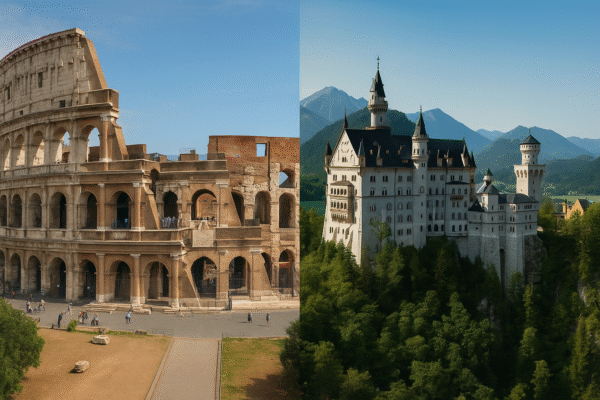Top 5 Countries with the Most UNESCO World Heritage Sites in 2025: Explore the World’s Richest Cultural Treasures
UNESCO World Heritage Sites are some of the planet’s most extraordinary cultural, historical, and natural treasures—each one telling the story of human creativity, evolution, and natural wonder. As of 2025, five countries lead the world in the number of UNESCO-listed sites: Italy, China, Germany, France, and Spain. These nations offer travelers an unparalleled opportunity to explore living history and breathtaking landscapes that span centuries of civilization and innovation.
Here’s a guide to the top five countries with the highest number of UNESCO World Heritage Sites in 2025, each destination a testament to humanity’s shared legacy.
1. Italy – 60 Sites: An Immersive Time Capsule
Italy continues to hold the crown with 60 UNESCO World Heritage Sites, making it a must-visit for history enthusiasts and culture seekers alike. The country is often referred to as an open-air museum, where nearly every city and town holds artistic and architectural masterpieces.
Highlights include the Historic Centre of Rome, home to the Colosseum, Roman Forum, and Pantheon, and the Historic Centre of Florence, the birthplace of the Renaissance. Venice, with its lagoon and canals, offers a surreal experience of art and urban innovation.
Natural heritage is just as impressive. The Dolomites in northern Italy offer stunning alpine scenery and geological significance. From Pompeii’s ancient ruins to Sicily’s Mount Etna, Italy’s UNESCO sites celebrate both the grandeur and fragility of human achievement and natural beauty.
2. China – 59 Sites: Legacy of Dynasties and Natural Wonders
China ranks just behind Italy with 59 UNESCO World Heritage Sites, offering a powerful mix of imperial history and ethereal landscapes. The country’s cultural legacy spans over 5,000 years and is reflected in architectural marvels and sacred sites.
Among the most famous is the Great Wall of China, a colossal monument to ancient military engineering. The Forbidden City in Beijing, once the imperial palace, houses one of the world’s largest collections of ancient wooden structures.
For nature lovers, the South China Karst and Huangshan (Yellow Mountains) offer stunning views and deep spiritual significance. Sites such as the Mogao Caves in Dunhuang contain rare Buddhist art that dates back over a millennium, while the Terracotta Army in Xi’an immortalizes the first Emperor’s reign.
China’s diverse heritage sites are carefully preserved, with ongoing support from the National Cultural Heritage Administration and UNESCO Beijing Office.
3. Germany – 54 Sites: Art, Industry, and Green Heritage
Germany, home to 54 UNESCO World Heritage Sites, reflects a profound balance between cultural depth, natural landscapes, and industrial legacy. Its heritage is both majestic and modern.
Berlin’s Museum Island offers an unrivaled collection of archaeological treasures, while the Würzburg Residence displays baroque opulence and landscaped gardens. In contrast, the Zollverein Coal Mine Industrial Complex in Essen showcases the significance of industrial heritage and design.
Natural treasures include the Wadden Sea, one of the world’s largest tidal ecosystems, shared with the Netherlands and Denmark. Germany also protects prehistoric pile dwellings around the Alps and medieval town centers like Regensburg.
Germany’s Federal Foreign Office and Deutsche UNESCO-Kommission actively contribute to heritage conservation and cultural tourism promotion across its federal states.
4. France – 53 Sites: Cradle of Culture and Architecture
France’s 53 UNESCO World Heritage Sites encapsulate centuries of artistic triumphs, revolutionary thought, and natural harmony. From prehistoric caves to Gothic cathedrals, France is a global hub of creativity.
The Banks of the Seine in Paris include iconic landmarks such as Notre-Dame Cathedral, the Eiffel Tower, and the Louvre Museum. The Palace of Versailles, a masterpiece of royal architecture, stands as a symbol of France’s monarchical history.
In the south, the Pont du Gard and historic cities like Avignon transport visitors back to Roman and medieval times. The Lascaux Caves, though closed to the public, preserve Stone Age art that changed how we understand prehistoric expression.
France’s commitment to cultural preservation is backed by the Ministère de la Culture and Centre des monuments nationaux, ensuring that these sites remain accessible and well-maintained.
5. Spain – 50 Sites: A Tapestry of Civilizations
With 50 UNESCO World Heritage Sites, Spain is a mosaic of Moorish, Christian, Roman, and modernist influences. Its diversity is reflected in both architecture and intangible cultural heritage.
Southern Spain’s Alhambra in Granada epitomizes Islamic artistry, while Barcelona’s Gaudí landmarks, including La Sagrada Familia and Park Güell, reveal the genius of modernist design. Santiago de Compostela, the endpoint of the Camino de Santiago, remains one of Europe’s most significant pilgrimage routes.
The Historic Centre of Córdoba, with its Mezquita-Catedral, showcases coexistence of cultures. Roman aqueducts, prehistoric caves, and remote monasteries round out Spain’s offering of unforgettable sites.
Spain’s Ministry of Culture and Sport works closely with ICOMOS Spain and UNESCO to support heritage initiatives and sustainable tourism.
A Global Invitation to Discover UNESCO’s Living Legacy
These five countries—Italy, China, Germany, France, and Spain—are more than just top tourist destinations. They are guardians of humanity’s greatest achievements in art, architecture, faith, and nature. As UNESCO continues to expand its list of protected sites, these countries remind travelers that the world is not just a place to visit—it is a rich narrative to understand and preserve.
For travelers seeking more than just sightseeing, UNESCO World Heritage travel offers deep connection, education, and awe. Whether you’re tracing Roman roads, gazing at Buddhist murals, or hiking ancient landscapes, the journey becomes a timeless adventure.
For more travel news like this, keep reading Global Travel Wire















